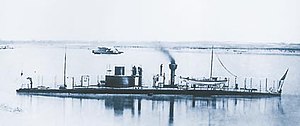SMS Leitha
The construction of the first Danube monitors was dictated by the Monarchy's foreign policy ambitions, and the military and economic situation of the times.
The ambition of becoming a great continental power turned the attention of the Austro-Hungarian Monarchy in the direction of the Balkans as it could not expand towards the West.
However, the Monarchy had to be prepared to compensate the states along the Danube, which had been newly liberated from Turkish rule, and that of Czarist Russia.
To gain more influence in the Balkans[1] therefore the commander of the Monarchy's naval fleet, admiral Wilhelm von Tegetthoff suggested the construction of monitor type warships.
He had to take into consideration the fact that because of the low average depth of the Hungarian rivers, he could only build shallow-draft ships, which made his task very difficult, given that warships are very heavy due to their armour and weaponry.
With a low-freeboard, the ship needed less armour, ending up with a draft of just 1.3 m. The first monitor was built in the American Civil War, which was between the Northern, Union and Southern, Confederate states, the Northern states introduced an innovation in military technology, USS Monitor, designed by the Swede, John Ericsson.
[5] After that, she performed routine duties on the Danube and tributaries until 1892, when the Austro-Hungarian Navy decided to build two new, modern monitors, to be named Koros and Szamos.
[7] The first Hungarian war hero of the Austro-Hungarian Navy, sailor János Huj, serving aboard Leitha, was killed in these battles (12 August).
[8] The ship's greatest damage occurred in October 1914, during the first occupation of Belgrade, when the turret suffered a direct hit, all the crew inside being killed.
[9] Yet, the short-term Soviet Republic in Hungary in 1919, urged the reinstatement of the Danube fleet, therefore the vessel, by that time renamed Lajta was deployed once more.
A military takeover was to be organized in Budapest as a demonstration against the current communist dictatorship, and a very important part would have been naval support from the Danube.
[10] In 1921, under the control of the Entente Powers who did not need her due to her old age, the armament, armour and the machinery of Lajta was removed, and she was sold at auction.
An enterprise from Budapest bought the monitor in 1928, converted her to an elevator ship (which can convey the mined gravel to the river bank from barges), by constructing a conveyor belt and associated machinery on board.
An Austrian engineer, Friedrich Prasky, identified her, and András Margitay-Becht helped to get her back from the Swiss company, and later on he worked to establish the history of the ship scientifically.
The minister, Csaba Hende, declared Lajta the honorary flagship of the Hungarian Army's river warship regiment.
The flag of the Austro-Hungarian Monarchy can also be found here, which was used on all vessels of the Empire, both warships and merchant ships, after the order of Joseph II of 1786 which came into force on 1 January 1787.
After the Reconciliation (Ausgleich) of 1867, merchant sea ships of the Dual Monarchy wore a different ensign: a combination of the Austrian and Hungarian colours, with their respective coats of arms.

